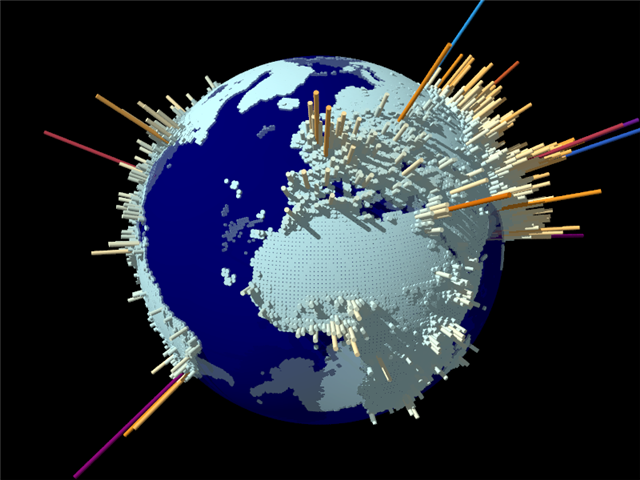About the global: modeling the creation / resolution of problems

About global
What do we see as friends in the yard, classmates, fellow students? What do we see in schools, children's camps, universities? We are observing the larva of society. The larva grows and turns into an adult - a generation. A generation filling prisons, selling bread, treating liver, repairing pipes, writing code, taking bribes, saving lives, putting emergency lights on roofs.
Independently of the state, we ourselves create groups and public pages on social networks to help homeless animals, collect money for operations for children and adults in the same place, coordinate our actions to raise money to help orphanages and orphanages. We create service sites for information on forest fires, city problems, floods and floods, trends on Twitter, we create entire platforms for visualizing problems on the map. As a result, we have a fragmented set of services and tools for solving problems.
Will homeless animals disappear in 5 years? In 10? Orphans disappear? Will the old people disappear? Will the forests stop burning? Will there be less reason for criminals to appear?
Their problems will remain.
We are trying to treat the diseased, correct, fight with what we have at the output, what happens in the end, and not what leads to it.
Idea
We are aware of cases of the collapse of various types of economies, their models, political systems and, as a result, social problems that arise after these events. We are aware of cases of mass epidemics, world wars and civil unrest. What kind of world will your children live in? What kind of people in the same society do they have to work with? What air will they breathe? What kind of water will they drink? History does not know the “would” particle, but the Future tells us all that you know - it means it is armed.
In scientific and technical creativity, there is a principle similar to the motto "there is no limit to perfection." For the consistent application of this principle to the development of society and the analysis of results, you need to live two or three lives, perhaps. It's a shame if the deterioration of all indicators of interest becomes the result of the life of several generations.
How to get results painlessly, anticipate changes and not spend generations on it, not break people's destinies and lives?
We invent the future, make films about it, write books, invent, decipher the human genome, send mobile laboratories to Mars. We have access to computing power ( http://habrahabr.ru/company/ibm/blog/154275/ ), a billion people are involved in social networks ( http://habrahabr.ru/post/153583/ ). We create simulation applications for the development of human civilization. We even play simulations for 10 years ( http://habrahabr.ru/post/145716/ ). We study epidemics in virtual worlds ( http://soft.mail.ru/pressrl_page.php?id=23653) But how few people know about the results of these studies! How long have the results been embedded in the curriculum! Who tried to popularly highlight the data from these studies?
Sentence:
- creating the most approximate model - a planet simulator;
- collection of initial input data;
- free access to raw output;
- interpretation of the output by experts and comers;
- free access to processed data;
- creation of a platform for modeling the development of the planet under free licenses;
- running multiple instances of simulation models with different conditions:
- the simulation is limited to a finite period of time;
- The simulation is not limited in time;
- the simulation is limited to time intervals, but is adjusted in accordance with the real data of the real world on the basis of data at the time of the next launch (in fact, the multiple case of launching the first option);
- simulation of an initially perfectly tuned model (ideal input data laid);
- simulation with theoretical types of economies and / or state systems;
- other options.

Input data:
- the set of all states, their location and territory;
- number of population, nationalities, nationalities, races;
- many religions, cultures, mentality;
- the state of accessible technology, science and art;
- state of the economy of states;
- climate;
- tectonic, geomagnetic and space features of the planet;
- levels of development of medicine, epidemics and biological characteristics of peoples;
- other data and parameters.
Application of simulation results:
- free access to simulation results;
- making forecasts;
- long-term planning;
- definition of new input data for experimental simulation parameters.
Problems:
- accessibility and involvement of the whole world;
- language barrier;
- collecting opinions / collecting data on public opinion (the farmer in Beloyarsky or the turner in Saratov is hardly interested in the Internet at all (at least in this generation));
- monitoring;
- cultural characteristics and differences in mentality, language;
- predictions and influences of possible discoveries and inventions.
Conclusion
I foresee a lot of indications of Taleb's “Black Swans” , “Limits of Growth” , the passionary theory of ethnogenesis , but they are also theories. Testing on a living and involving people in doubtful changes is akin to the Chinese curse “So that you live in an era of change!”. Let surrogate models in the accelerated mode give answers to these global questions.
Source image: http://www.flickr.com/photos/arenamontanus/375127836/ .
PS
For dessert, the video that once pushed me to this post:
